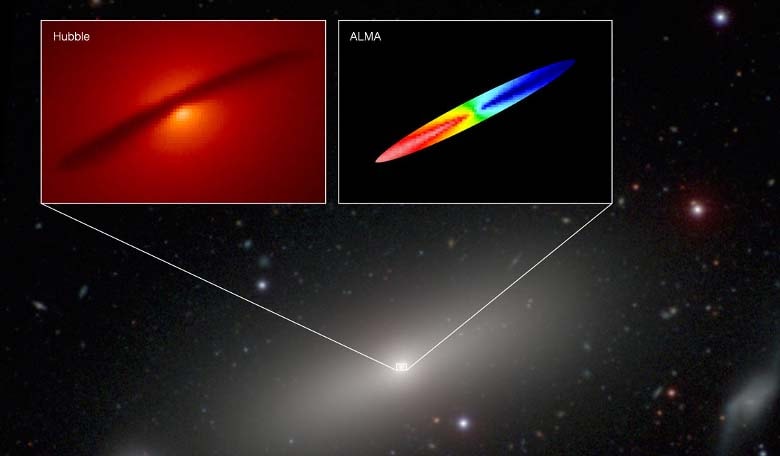Using the Atacama Large Millimeter/submillimeter Array (ALMA), a team of astronomers has delved deep into the heart of a massive elliptical galaxy approximately 73 million light-years from Earth, to provide one of the most accurate mass measurements for a black hole outside of our Galaxy.
Weighing millions to billions of times the mass of the Sun, supermassive black holes are found in the centre of galaxies and it is surmised that perhaps most galaxies, if not all, harbour such a massive object at their core. The nearest one resides in the centre of our Milky Way galaxy 28 thousand light years away, while the most distant one known can be found in a quasar galaxy billions of light years away.
To determine the actual mass of a supermassive black hole, researchers measure the speed of the orbiting material, stars and clouds of gas, that swarm around it – a method that lead author of a recent research paper, Aaron Barth, an astronomer at the University of California, Irvine (UCI), and his team used to measure the speed of carbon monoxide gas swirling around the black hole at the centre of NGC 1332, a massive elliptical galaxy in the direction of the southern constellation Eridanus.
"Measuring the mass of a black hole accurately is very challenging, even with the most powerful telescopes on Earth or in space," said Barth. "ALMA has the revolutionary ability to observe disks of cold gas around supermassive black holes at small enough scales that we can clearly distinguish the black hole's influence on the disc's rotational speed."
One advantage that ALMA has over other telescopes is its high resolution, coupled with its ability to ‘see’ the densest, coldest component of the disc, the close-in observations provided researchers with crucial information to help differentiate between the gravitational influence of the black hole on the gas surrounding it against the pull of gravity from all of the other material that comprises most of the galaxy's overall mass.
Analysis of the observations for the black hole at the centre of NGC 1332, have revealed that gas near the disc's centre is traveling at more than 500 kilometres per second and by comparing this data with simulations, Barth and his team calculated that the black hole has a mass 660 million times greater than our Sun, plus or minus ten percent and is about 150 times the mass of the black hole at the centre of the Milky Way.
"This black hole, though individually massive, accounts for less one percent of the mass of all the stars in the galaxy," explained Barth. "Most of a galaxy's mass is in the form of dark matter and stars, and on the scale of an entire galaxy, even a giant black hole is just a tiny speck in the centre. The key to detecting the influence of the black hole is to observe orbital motion on such small scales that the black hole's gravitational pull is the dominant force."
This observation is the first demonstration of this capability for ALMA and has helped constrain the actual mass of the black hole, as previous studies of NGC 1332 with ground- and space-based telescopes have suggested the mass is anywhere between 500 million to 1.5 billion times the mass of the Sun."ALMA can map out the rotation of gas discs in galaxy centres with even sharper resolution than the Hubble Space Telescope," noted UCI graduate student Benjamin Boizelle, a co-author on the study. "This observation demonstrates a technique that can be applied to many other galaxies to measure the masses of supermassive black holes to remarkable precision."











